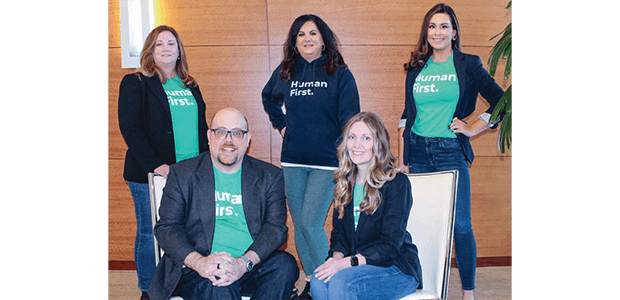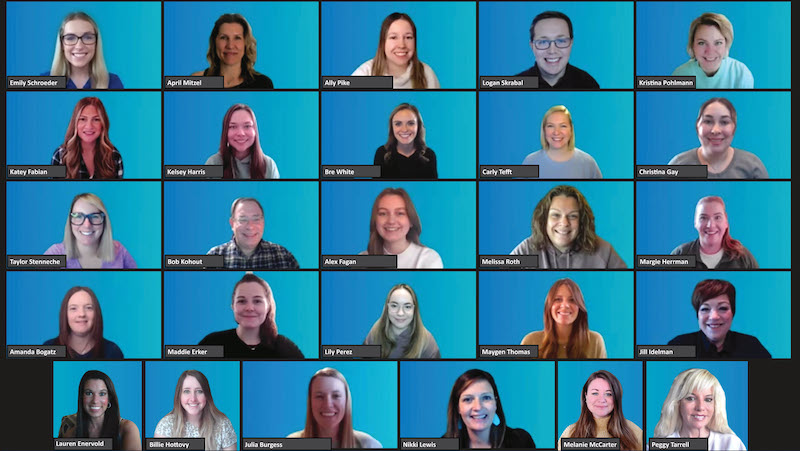
After nearly doubling in size in the last two years through acquisitions, Medical Solutions expected to experience some growing pains. But a variety of strong training programs focused on integration, communication, transparency, and inclusion have helped the healthcare staffing company reach new heights, including earning the #1 ranking on the 2022 Training APEX Awards list.
“Our approach has been ‘right, not rushed,’ which comes with the need to support multiple diverse lines of business, each with their own formal process, structure, systems, and roles. Effectively, we are managing separate learning opportunities in many facets of our business while identifying opportunities for some unity across our brands,” explains Director of Learning & Development Katie Kuhl. “To meet this challenge, many of our L&D team members, as well as leaders and other stakeholders, are learning the business for each line in order to support and drive business initiatives forward. We are creating new roles in the business with the core responsibility of learning and mapping our processes and systems, and making proposals for how to work better prior to, during, and after we are able to fully integrate. This has allowed greater vision and understanding of how to move forward ‘stronger as one.’”
INTEGRATION STABILIZATION
The continuation of a large-scale integration last year brought about many new roles specifically for identifying and anticipating the needs of Medical Solutions’ future workforce. Not only did the organization grow by 45 percent, but its L&D team doubled in size, as well, adding an Integration Training specialist and several Tech and Systems facilitators to the Tech and Systems project management team.
Integrating a business brand is no easy feat, Kuhl emphasizes. “We relied heavily on our CEO, COO, and general council to serve as advocates throughout the integration process and training. “Together, our executive team would send a One-Minute Integration Update video to the entire enterprise, being transparent about the process, frustrations, and, even more importantly, the successes. This transparency from our top leaders proved to be an asset in garnering integration buy-in.”
The Integration Stabilization Room was a partnership between two of three merged business brands to transition acquisition Professional Placement Resources (PPR) fully onto Medical Solutions systems and processes. This training included multiple departments: L&D, IT, Sales, Support, Payroll, Billing, developers and enterprise project managers, and executive C-suite support. Set up following formal integration training efforts, the Integration Stabilization Room was a continuous Zoom room and Microsoft Teams chat environment over the course of three weeks (8 a.m. to 5 p.m. Monday through Friday) where employees could get the help they needed on the spot. Each day, the room hosts (IT developers, IT helpdesk employees, and two L&D trainers) compiled a list of frequently asked questions and reviewed common themes in a half-hour meeting with the enterprise project managers and executive suite.
“Medical Solutions had never executed an integration completely virtually—all prior integrations were executed with onsite L&D facilitators,” Kuhl relates. “This was an overhaul to business processes and an innovative change management process. By being in on the ground floor conversations, we were able to mediate some of the potential misinterpretations of information and identify additional areas of improvement.”
As a result, Kuhl says, overall resolution times were approximately three times more efficient than other internal resolution times. “The Integration Stabilization Room was slotted for three weeks, but we only needed the room for two weeks because of the efficiency in resolution rates for open tickets,” she notes.
The acquired business was fully integrated onto Medical Solutions’ PULSE system by March 2021—one month ahead of goal. Some 20 percent of PPR leaders stated that by day 7 of Integration Stabilization, their employees were easily and successfully navigating the PULSE system.

THE SOUL TRAIN(ING)
Chief Human Resources Officer Dana Coonce believes a key aspect of learning support within the organization is the visibility, accessibility, and communication with senior leaders. She says Medical Solutions’ senior leaders are some of the best coaches within the organization. “We dehne coaching as having regular structured conversations to enhance awareness and/or behavior. Our highest levels of executives—CEO, CFO, executive vice presidents, vice presidents, and directors—not only participate in but help facilitate much of our training through various programs such as New Hire Orientation, Leadership Onboarding, and Elevate Leadership. We not only want our leaders to be viewed as approachable experts within the organization, but also to model our culture of learning by being active participants and facilitators.”
Kuhl points to MedSoul Leadership as a critical first step in revitalizing current foundational leadership training to account for unprecedented business growth due to company growth and acquisitions. “MedSoul Leadership helps us understand not only how we live to our organizational values, but lead through them,” she explains. “In a time when many leaders are continuing to navigate new situations and challenges, and understanding how their approach through hybrid or remote work needs to change to support both employees and the business, it’s incredibly important to drive everything through a united lens.”
Many leaders don’t have all the answers to big questions in front of them and are growing in new skills, Kuhl says, “but if you can connect it all back to the purpose—the why—for your culture and business, it helps us all understand that we are in it together. Top-performing organizations know that purpose is both a differentiating factor and a must-have.”
L&D, in partnership with other HR leaders, launched the two-part MedSoul Leadership Training to the enterprise in July 2021. Part 1 includes an eight-step, on-demand training course. This online component includes a message from the CEO; a recorded session facilitated by the VP of Talent Engagement, director of Learning & Development, and senior director of Culture & Engagement; a self-assessment to determine a participant’s leadership style; and a team assessment to understand what drives their individual teams. It also outlines the leadership principles and demonstrates what leadership in action looks like.
After successful completion, the L&D team compiles quarterly reports and creates peer-to-peer learning communities through collaborative focus groups. Each quarter, a new community is brought together to build cross-business relationships, discuss relevant keys to success and leadership topics, and work to brainstorm solutions to workplace challenges. This three-month program (six total focus group meetings) aims to foster results-oriented discussions and formulate possible solutions.
More than 80 percent of leaders have participated in MedSoul Leadership across all business brands to date.
DEI: CONSISTENCY IS KEY
As a newly merged company, Medical Solutions is working harder than ever to create a diverse and inclusive workplace where employees feel valued, respected, supported, and can show up as their whole and authentic selves.
While Medical Solutions spans the entire United States, when coming together, Vice President of Talent Engagement Liz Hall says, each individual employee and business unit has presented unique needs/focal points for Diversity, Equity, and Inclusion (DEI) training efforts. “Our goal was to create a consistent DEI message, although not a one-size- fits-all solution. We needed to give our associates (and their families) a variety of ways to learn about and get involved with DEI.”
Part 1 of the three-part solution is a series of virtual, interactive workshops facilitated by Medical Solutions’ partners at Inclusive Communities to foster foundational knowledge and create greater understanding by examining and breaking down stereotypes, myths, and barriers among diverse identities. Each virtual session is five hours and has a maximum of 50 participants to promote engagement and interaction among breakout groups.
Part 2 focuses on the grassroots special interest group, the DEI Council. Geared to support those who want to take a more active role in championing DEI within the company, this council meets monthly to establish a monthly goal and identify one to two learning opportunities for the enterprise.
Part 3 includes an online, on-demand certification housed within the learning management system (LMS). Learners can enroll in this three-part course at any time. Upon successful completion, they receive the DEI Ambassador badge and can assist with facilitating DEI conversations among their teams/divisions.
In 2021, 428 employees participated in Inclusive Communities, 50 employees joined the Diversity Council, and 191 employees completed the online certification, for a total of 669 employees involved in DEI efforts. This is roughly 42 percent (18 percent less than goal) of the total employee population, Hall says, but it represents every business unit and department from all merged business affiliates.
GETTING IN THE TALENT RHYTHM
As with its DEI initiatives, trust plays a major role in career development at Medical Solutions. “Our company prides itself on transparency. Employees trust they will be heard and are empowered to bring about concerns in areas of their training, including skills gaps,” Coonce says. “We utilize annual role-specific and all-company surveys to determine which skills employees want to expand on for personal or professional growth.”
The company also implemented the Talent Rhythm Goal Setting Process, where employees identify goals they’d like to accomplish each year. “Learning experiences offered within our organization are customized based on the employee lifecycle,” Coonce explains. “We integrate all learning experiences into a system of structural gamification through our LMS. Each learning element offered has potential to award learners ‘experience points’ through badging recognition. This rewards continuous, long-term learning through immediate reinforcement when lessons and evaluations are completed.”
Overall, Coonce says, the Talent Rhythm process resulted in gathering more than 5,000 goals entered for review from 1,600 employees, contributing to the organization’s overall engagement score of 81 and helping Medical Solutions attain its goal of maintaining employee attrition of 5 percent or less.
A LEARN-IT-ALL MINDSET
In first quarter 2021, L&D conducted a company wide survey on workplace preferences. The outcome, Kuhl says, “was that less than 2 percent of employees indicated the desire to return to the office full time in a post-pandemic world. Based on those feelings, we will move forward with a permanent remote hybrid workforce, allowing our employees the choice of returning to the office when needed.”
Over the last year, Kuhl says L&D focused on transitioning from a virtual classroom model to more inclusive delivery styles, adapting many programs and courses to a self-paced approach.
L&D continues to train employees on how to maximize the features of Zoom, including white boards, breakout rooms, annotations, remote control, and polling, Hall says. “We’ve also expanded productive individual and group interactions through Microsoft Teams.”
Additionally, L&D curated and shared content that supports employees in remote work settings and influences their whole-person experience. Topics include virtual mental health, avoiding burnout, elevating presence in virtual meetings, time management, and making connections. “We’ve also crafted coffee chats, lunch & learns, exercise groups, and other interactions based on special interests to drive high levels of engagement and simulate experiences typically gained while in office,” Hall says.
Looking ahead, Kuhl believes, “we can no longer use ‘what’s always worked.’ Instead, we must get out of the box, turn it around, cut it apart, and change its shape completely. We must focus efforts on driving the needle and educating our employees on not only how their technology works today, but how it can and will work in the future. We must focus on building an empowered workforce that isn’t afraid to fail while trying new things. We need to build an experiment-and-learn culture to grow talent and our business, shifting from a know-it-all culture to a more curious learn-it-all mindset.”

